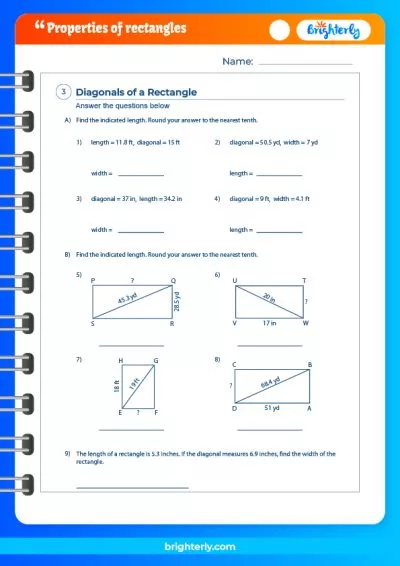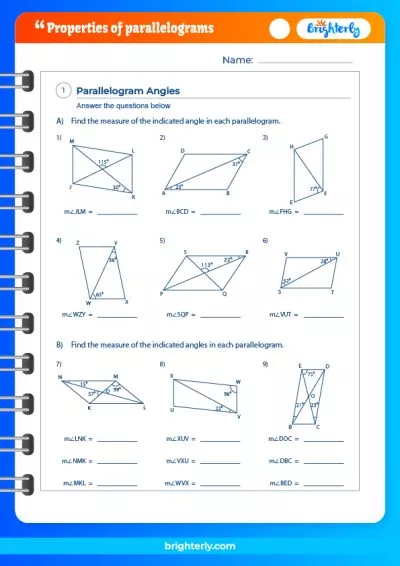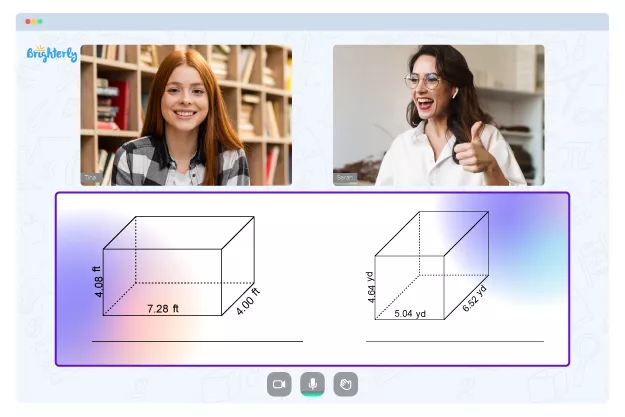Parallelogram – Definition with Examples
Created on Jan 12, 2024
Updated on January 13, 2024
Welcome to the fascinating world of parallelograms, where we explore the realm of quadrilaterals with parallel sides. At Brighterly, we believe in making math engaging and fun for children, and parallelograms are no exception. With their unique properties and versatile nature, parallelograms offer a gateway to understanding more complex geometric concepts. In this comprehensive guide, we’ll dive deep into parallelograms, exploring their properties, types, and various applications. So, buckle up and join us on this exciting journey through the world of parallelograms, where math and creativity intersect to create a vibrant and captivating learning experience.
What is a Parallelogram?
A parallelogram is a special type of quadrilateral (a polygon with four sides) where both pairs of opposite sides are parallel. In other words, a parallelogram is a flat, four-sided figure with opposite sides that are equal in length and parallel to each other. It comes from the Latin word parallelogrammum, which means “bounded by parallel lines.” Parallelograms are a significant part of the geometry curriculum and can be found in various shapes and sizes in our everyday world. They are commonly used in architecture, design, and engineering, making them an essential concept for students to understand.
Properties of a Parallelogram
A parallelogram has several unique properties that distinguish it from other quadrilaterals. These properties are:
- Opposite sides are parallel and equal in length.
- Opposite angles are equal.
- Consecutive angles are supplementary (add up to 180°).
- The diagonals bisect each other.
- If a quadrilateral has one pair of opposite sides equal and parallel, it is a parallelogram.
By understanding these properties, students can easily identify and work with parallelograms in various mathematical problems and real-world applications.
Now that you’ve learned about parallelograms and seen some examples, it’s time to practice! Brighterly offers the best worksheets for kids, where you can find plenty of problems to practice your skills.
Types of Parallelogram
There are several types of parallelograms, each with its unique characteristics. Some common types include:
- Rectangle: A parallelogram with all angles equal to 90°.
- Rhombus: A parallelogram with all sides equal in length.
- Square: A parallelogram that is both a rectangle and a rhombus, with all sides equal in length and all angles equal to 90°.
By knowing the different types of parallelograms, students can apply this knowledge to various geometric problems and gain a deeper understanding of the properties of these shapes.
Shape of Parallelogram
The shape of a parallelogram can vary greatly depending on the angles and side lengths. However, all parallelograms share the same fundamental characteristics, such as parallel opposite sides and equal opposite angles. This means that, regardless of its specific shape, a parallelogram will always have the same basic properties. For example, a rectangle has a more regular shape with right angles, while a rhombus has equal side lengths but may have varying angles. Despite their differences, both are considered parallelograms and share the same fundamental properties.
Special Parallelograms
Special parallelograms are those that have additional properties beyond the standard properties of a parallelogram. These include:
- Rectangle: All angles are 90°, and diagonals are equal in length and bisect each other.
- Rhombus: All sides are equal in length, and diagonals are perpendicular and bisect each other.
- Square: Combines the properties of both rectangles and rhombuses, with all sides equal in length, all angles equal to 90°, and diagonals equal in length, perpendicular, and bisecting each other.
Understanding special parallelograms helps students recognize the relationships between different geometric shapes and apply these concepts to solve problems.
Angles of Parallelogram
The angles of a parallelogram have unique properties that can be used to solve various geometric problems. Some key properties of parallelogram angles are:
- Opposite angles are equal (α = γ, and β = δ).
- Consecutive angles are supplementary (α + β = 180°, and γ + δ = 180°).
- The sum of all angles in a parallelogram is always 360° (α + β + γ + δ = 360°).
These properties can be used to find missing angles in a parallelogram when given certain information, such as the measure of one angle or the relationship between different angles.
Properties of Parallelogram
As mentioned earlier, a parallelogram has several unique properties that set it apart from other quadrilaterals. To reiterate, these properties are:
- Opposite sides are parallel and equal in length.
- Opposite angles are equal.
- Consecutive angles are supplementary (add up to 180°).
- The diagonals bisect each other.
- If a quadrilateral has one pair of opposite sides equal and parallel, it is a parallelogram.
Understanding these properties is crucial for solving geometry problems involving parallelograms and recognizing their presence in real-world applications.
Formulas (Area & Perimeter)
Calculating the area and perimeter of a parallelogram involves using specific formulas:
- Area: A = base × height
- Perimeter: P = 2 × (side1 + side2)
The area formula requires the length of the base and the height (the perpendicular distance between the base and the opposite side). The perimeter formula requires the length of all sides or the length of the two pairs of equal sides.
Solved Examples
Let’s look at some examples to better understand how to work with parallelograms.
Example 1
Find the area and perimeter of a parallelogram with base 10 units, height 6 units, and side length 8 units.
Solution:
Area = base × height = 10 × 6 = 60 square units Perimeter = 2 × (side1 + side2) = 2 × (10 + 8) = 2 × 18 = 36 units
Example 2
If the opposite angles of a parallelogram are 75° and 105°, find the other two angles.
Solution:
Since opposite angles are equal: Angle1 = 75° Angle2 = 105° Angle3 = 75° (opposite of Angle2) Angle4 = 105° (opposite of Angle1)
Example 3
Find the length of the diagonals of a square with side length 4 units.
Solution:
In a square, the diagonals are equal in length and can be found using the Pythagorean theorem:
Diagonal length = √(side² + side²) = √(4² + 4²) = √(16 + 16) = √32 = 4√2 units
Difference Between Parallelogram and Rhombus
A rhombus is a special type of parallelogram where all sides are equal in length. While both shapes have parallel opposite sides and equal opposite angles, a rhombus has the additional property of equal side lengths. Additionally, the diagonals of a rhombus are perpendicular and bisect each other, while the diagonals of a general parallelogram only bisect each other. Understanding the differences between a parallelogram and a rhombus can help students accurately identify and work with these shapes in various mathematical problems.
Practice Questions on Parallelogram
Here are some practice questions to help reinforce your understanding of parallelograms:
- Find the area of a parallelogram with base 12 units and height 5 units.
- Calculate the perimeter of a parallelogram with side lengths 7 units and 9 units.
- If one angle of a parallelogram is 110°, find the other three angles.
- In a rectangle, the length is 15 units, and the width is 8 units. Calculate the area and perimeter.
Solving these practice questions will help solidify your understanding of the concepts and formulas associated with parallelograms.
Conclusion
Parallelograms play a vital role in the fascinating world of geometry, making it imperative for young learners at Brighterly to comprehend their properties, types, and formulas for a strong foundation in mathematics. By mastering these concepts, our inquisitive students can unleash their full potential to tackle a wide array of geometric problems, effortlessly linking them to real-world applications.
At Brighterly, we strive to provide our budding mathematicians with the tools and knowledge they need to recognize and appreciate the beauty of parallelograms in daily life. From architecture to design, and even in nature, parallelograms are everywhere, waiting to be discovered by our curious learners.
Frequently Asked Questions On Parallelogram
What is the main characteristic of a parallelogram?
The main characteristic of a parallelogram is that both pairs of opposite sides are parallel.
Are all rectangles parallelograms?
Yes, all rectangles are parallelograms, as they have parallel opposite sides and equal opposite angles.
How can you prove a quadrilateral is a parallelogram?
A quadrilateral can be proven to be a parallelogram if one pair of opposite sides is equal in length and parallel, or if the diagonals bisect each other.
How do you find the missing side of a parallelogram?
To find the missing side of a parallelogram, use the properties of parallelograms (opposite sides are equal in length) and any given information about the shape.
Can a parallelogram have right angles?
Yes, a parallelogram can have right angles. A rectangle is an example of a parallelogram with right angles.






